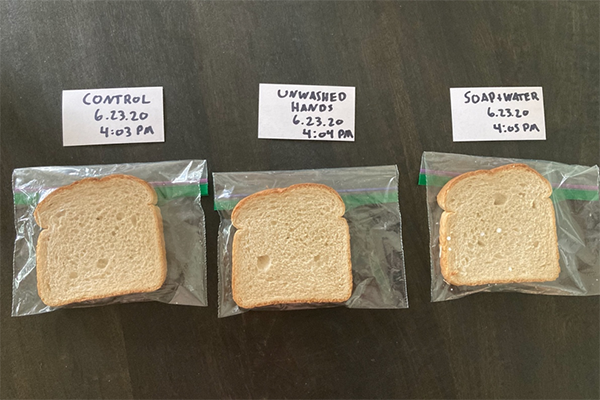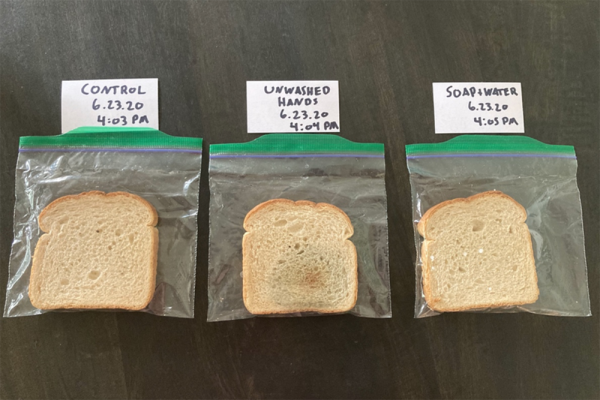Written by Nicholas Ogle
October 16, 2020
With the recent COVID-19 outbreak, microbiology has become an interest for everyone, not just scientists and researchers. The idea of viruses and bacteria on surfaces is not a new one, but now more than ever, battling their spread and growth is part of our collective conscience. According to Prem Chapagain, associate director of the Biomolecular Sciences Institute at FIU, hand washing and sanitizer can help.
“Many pathogens transmit from one person to another via contacts with commonly touched surfaces such as door handles, front desks and paper money,” Chapagain said.
In the lab, the study of the host/pathogen relationship can be complicated, requiring an assortment of equipment, including petri dishes, nutrient agar and counting plates.
With a few simple household items, it is possible to conduct an experiment at home to investigate different surfaces and how handwashing and sanitizer can help us in the battle against the spread of pathogens such as COVID-19.
MATERIALS
Using bread as a substitute for the host and bread mold as a substitute for the pathogen, creating an at-home petri dish can be accomplished using a few items found in most households.
- Sealable plastic sandwich bags
- Clean tongs
- Bread slices
- Hand soap
- Marker
QUESTION – RESEARCH – HYPOTHESIS
Every proper experiment begins with a question. In this case, the effectiveness of handwashing or what surfaces are most risky may come to mind. From the information gathered by research, you can form a hypothesis. A good hypothesis is not simply an educated guess, but an if-then statement that can be tested. For this experiment, a good example is: “If washing hands with soap and water reduces the spread and growth of microbes, then the bread slice touched with unwashed hands will demonstrate more mold growth than the bread slice touched after washing hands with soap and water.”
METHOD
When planning an experiment, recording all steps and procedures is essential. The true power of the scientific method is the ability for the experiment to be replicated. The most reliable results come from an experiment that has been repeated numerous times by different people and groups who all get the same results. To begin, assemble all materials in one place on a clean and sanitized surface.
- Using a clean set of tongs, remove a slice of bread and place it in a sealable plastic bag. Take care not to touch the bread or the inside of the bag with your hands. Seal the bag. Mark the bag as “Control” with the date and time. The control is used to make sure the variables being introduced are causing the changes that are observed. In this case, it allows us to confirm that mold growth is the result of germs from our hands rather than the bread molding on its own.
- Remove another slice of bread using the tongs. Have all members of your family participating in the experiment touch both sides of the bread without washing their hands and place it in the plastic bag. Seal the bag. Mark the bag as “Unwashed Hands” with the date and time.
- Have all experiment participants wash their hands with soap and water for 20 seconds. Remove a slice of bread using the tongs. Have all participants touch both sides of the bread with their washed hands as they did in step 3. Seal the bag. Mark the bag as “Washed – Soap and Water” and mark with the date and time.
- Place the sealed bags in a location where environmental conditions such as temperature and sunlight are the same and observe.


Bread shown on the day the experiment was set up (L) and bread shown later with mold growing on the sample touched with unwashed hands (R).
OBSERVATION
Many different methods can be used to make observations. One example is a simple data sheet that allows for descriptions such as color or texture and measurements of mold size. Photo observation can also be useful, taking pictures each day to document the growth over time. Remember, detail is important so that others can replicate your experiment.
RESULTS - COMMUNICATION
It is now time to evaluate our hypothesis using the data collected. In this case, it appears the hypothesis was supported by the experiment. If the results don’t support the theory, that’s OK! Key information can still be gained and can be used to design the next experiment. It is also important to consider any steps that may have led to an error. Be sure to share results by tagging @FIUCASE and join the team of at-home scientists.
FOOD FOR THOUGHT
All bread is not created equal. Artificial preservatives are used in some bread specifically to prevent microbial growth and may hinder results. Freshly baked bread often does not include these preservatives and may be a better choice for the bread petri dish experiment.
NOW WHAT?
Design an experiment based on your own questions. Do you want to see if certain surfaces, such as a video game controller or TV remote have more germs? Be sure to use the same procedure for each surface you evaluate, such as washing hands before touching each surface and then touching the bread slice. Is washing your hands with soap and water more effective than using hand sanitizer? Remember to always use a control and record your methods in detail to make your results as strong as possible. Tag @FIUCASE on social media to share and inspire others to create their own experiments.
To learn more about how microbes are studied in the lab and how students and researchers at FIU are combating life-threatening diseases one molecule at a time, visit the FIU College of Arts, Sciences & Education’s Biomolecular Sciences Institute.